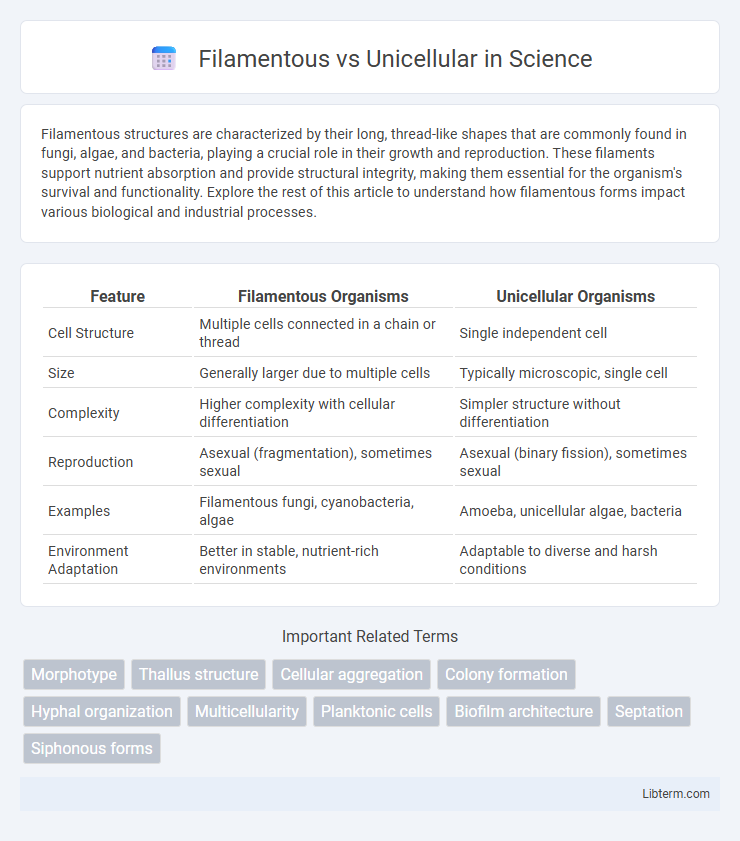Filamentous structures are characterized by their long, thread-like shapes that are commonly found in fungi, algae, and bacteria, playing a crucial role in their growth and reproduction. These filaments support nutrient absorption and provide structural integrity, making them essential for the organism's survival and functionality. Explore the rest of this article to understand how filamentous forms impact various biological and industrial processes.
Table of Comparison
| Feature | Filamentous Organisms | Unicellular Organisms |
|---|---|---|
| Cell Structure | Multiple cells connected in a chain or thread | Single independent cell |
| Size | Generally larger due to multiple cells | Typically microscopic, single cell |
| Complexity | Higher complexity with cellular differentiation | Simpler structure without differentiation |
| Reproduction | Asexual (fragmentation), sometimes sexual | Asexual (binary fission), sometimes sexual |
| Examples | Filamentous fungi, cyanobacteria, algae | Amoeba, unicellular algae, bacteria |
| Environment Adaptation | Better in stable, nutrient-rich environments | Adaptable to diverse and harsh conditions |
Introduction to Filamentous and Unicellular Organisms
Filamentous organisms consist of elongated, thread-like chains of cells that form multicellular structures, enabling complex organization and specialization. Unicellular organisms, in contrast, are single-celled entities that perform all necessary life functions within one cell, exhibiting simplicity and adaptability. Understanding the differences between filamentous fungi or algae and unicellular bacteria or protozoa highlights diverse evolutionary strategies for survival and reproduction.
Structural Differences: Filamentous vs Unicellular Forms
Filamentous organisms consist of long, thread-like chains of connected cells that create a multicellular structure, allowing for specialization and efficient nutrient transport. Unicellular organisms exist as single, independent cells with all life functions contained within one unit, leading to simpler structural organization. The filamentous form enables greater surface area for absorption and interaction with the environment, whereas unicellular forms prioritize rapid reproduction and mobility.
Evolutionary Background and Significance
Filamentous organisms, composed of connected cells forming thread-like structures, evolved to optimize nutrient absorption and environmental interaction, contrasting with unicellular organisms that rely solely on individual cell functions. The transition from unicellular to filamentous forms represents a key evolutionary step towards multicellularity, enhancing survival through cellular specialization and cooperation. This evolutionary advancement underpins complex life forms by enabling more efficient resource distribution and adaptive responses to environmental challenges.
Habitat Preferences and Distribution
Filamentous organisms thrive in diverse aquatic and terrestrial habitats, often forming complex networks in freshwater, marine environments, and moist soils, which enhances nutrient absorption and stability. Unicellular organisms exhibit a broader distribution, inhabiting extreme environments such as hot springs, acidic waters, and deep-sea vents, reflecting their adaptability to varying conditions. The habitat preference of filamentous species promotes community structures, while unicellular species demonstrate flexibility and widespread dispersal across ecological niches.
Reproduction Strategies
Filamentous organisms reproduce through fragmentation and spore formation, enabling rapid colonization and resilience in fluctuating environments. Unicellular organisms rely primarily on binary fission, budding, or multiple fission, which facilitates quick population growth and genetic variation through processes like conjugation. These distinct reproductive strategies influence ecological roles, with filamentous forms often dominating structured habitats and unicellular forms thriving in variable, nutrient-rich environments.
Functional Adaptations and Survival Mechanisms
Filamentous organisms, such as certain algae and fungi, exhibit functional adaptations like enhanced nutrient absorption through increased surface area and structural resilience allowing them to withstand environmental stress. Unicellular organisms adapt by employing rapid reproduction, efficient nutrient uptake via specialized membrane transport systems, and forming protective cysts or spores to survive harsh conditions. These survival mechanisms enable both filamentous and unicellular forms to thrive across diverse and fluctuating ecosystems.
Ecological Roles in Natural Ecosystems
Filamentous organisms, such as certain algae and fungi, form complex networks that stabilize soil structures and enhance nutrient cycling in aquatic and terrestrial ecosystems. Unicellular organisms, including bacteria and protozoa, drive essential processes like decomposition, nitrogen fixation, and primary production at the microbial scale, supporting food webs and ecosystem functioning. Both forms contribute uniquely to ecological balance by facilitating energy flow, promoting biodiversity, and regulating biogeochemical cycles in natural habitats.
Industrial and Biotechnological Applications
Filamentous organisms, such as filamentous fungi and certain bacteria, offer advantages in industrial enzyme production due to their extensive mycelial networks that facilitate substrate penetration and high yields; unicellular microorganisms like yeast and algae provide rapid growth rates and easier genetic manipulation for scalable biotechnological processes. Filamentous fungi are widely used in producing organic acids, antibiotics, and enzymes, while unicellular microbes are preferred for biofuel production, recombinant protein synthesis, and food fermentation. Understanding the morphological differences enhances strain selection and optimization in biotechnology, leading to improved process efficiency and product quality.
Advantages and Limitations of Each Form
Filamentous organisms provide structural support and enable efficient nutrient transport across cells, enhancing growth in stable environments, but they face limitations in flexibility and rapid adaptation to changing conditions. Unicellular organisms excel in quick reproduction and adaptability due to their simple structure, allowing survival in diverse and fluctuating habitats, yet they often lack the resource sharing and specialization found in filamentous forms. The choice between filamentous and unicellular forms depends on environmental stability and resource availability, influencing their ecological success and evolutionary strategies.
Future Perspectives and Research Directions
Future perspectives in filamentous vs unicellular research emphasize advancements in genetic engineering and synthetic biology to enhance industrial biotechnology applications. Ongoing studies aim to optimize metabolic pathways in filamentous fungi for sustainable production of biofuels, pharmaceuticals, and enzymes. Emerging research focuses on integrating multi-omics data and machine learning to unravel complex cellular interactions and improve strain design for bioprocess efficiency.
Filamentous Infographic

 libterm.com
libterm.com